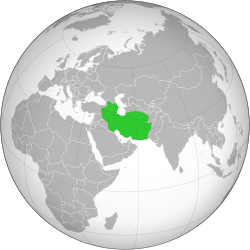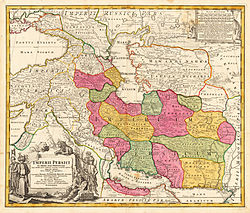
Back Safawi ACE Safawiden Afrikaans Safawiden ALS Dinastía Safavida AN السلالة الصفوية Arabic صفويين ARZ Səfəvi xanədanı Azerbaijani صفوی خاندانی AZB Сәфәүиҙәр Bashkir Сефевіды Byelorussian
Negara Agung Iran Raya ملک وسیعالفضای ایران Negara Iran مملکت ایران | |||||||||||||||
|---|---|---|---|---|---|---|---|---|---|---|---|---|---|---|---|
| 1501–1736 | |||||||||||||||
Bendera Safawiyyah sejak abad ke-17.[4]
Salah satu lambang Safawiyyah.[3]
| |||||||||||||||
 Peta Globe negeri Safawiyyah Iran | |||||||||||||||
 Peta pembagian Administrasi Pemerintahan di Persia selama Dinasti Safawi | |||||||||||||||
| Status | Kekaisaran | ||||||||||||||
| Ibu kota | Tabriz (1501–1555) Qazvin (1555–1598) Isfahan (1598–1722) | ||||||||||||||
| Bahasa yang umum digunakan | Persia[5] dan Azerbaijan[6][7][8][9] | ||||||||||||||
| Agama | Syiah[10] | ||||||||||||||
| Pemerintahan | Monarki | ||||||||||||||
| Shahanshah | |||||||||||||||
• 1501–24 | Ismail I | ||||||||||||||
• 1524–76 | Tahmasp I | ||||||||||||||
• 1587–1629 | Abbas I | ||||||||||||||
• 1694–1722 | Sultan Husayn | ||||||||||||||
• 1729–32 | Tahmasp II (restorasi) | ||||||||||||||
• 1732–36 | Abbas III | ||||||||||||||
| Wazir Agung | |||||||||||||||
• 1501-07 | Mohammad Zakariya Kujuji | ||||||||||||||
• 1731–36 | Nader Afshar (Restorasi) | ||||||||||||||
| Sejarah | |||||||||||||||
• Pendirian tarekat Safawiyyah oleh Safi-ad-din Ardabili | 1301 | ||||||||||||||
• Kampanye Ismail dan Pendirian negara Safawiyah | 1501 | ||||||||||||||
• Serangan Hotaki | 1722 | ||||||||||||||
• Penaklukan kembali oleh Nader Afshar | 1726–29 | ||||||||||||||
• Nader Shah dimahkotai | 1 Oktober 1736 | ||||||||||||||
| Luas | |||||||||||||||
| 2.850.000 km2 (1.100.000 sq mi) | |||||||||||||||
| Mata uang | Tuman, Abbasi, Shahi.[11]
| ||||||||||||||
| |||||||||||||||
| Sekarang bagian dari | |||||||||||||||
Dinasti Safawiyah (bahasa Persia: سلسلهٔ صفويان; bahasa Azerbaijan: صفویلر) adalah salah satu dinasti terpenting dalam sejarah Iran. Dinasti ini merupakan salah satu negeri Syiah terbesar semenjak runtuhnya Dinasti Syiah Fatimiyyah.[12][13][14][15] Negeri ini juga menjadikan Syiah sebagai agama resmi,[16] sehingga menjadi salah satu titik penting dalam sejarah Muslim. Safawiyyah berkuasa dari tahun 1501 hingga 1722 (mengalami restorasi singkat dari tahun 1729 hingga 1736). Pada puncak kejayaannya, wilayah Safawiyyah meliputi Iran, Azerbaijan, Armenia, sebagian besar Irak, Georgia, Afganistan, Kaukasus, dan sebagian Pakistan, Turkmenistan dan Turki. Safawiyyah merupakan salah satu negeri mesiu Islam selain Dinasti Qajar dan Dinasti Pahlevi .
Meskipun jatuh pada tahun 1736, salah satu warisan terbesarnya adalah kebangkitan Persia sebagai benteng ekonomi antara timur dan barat, pendirian negara yang efisien dan birokrasi yang didasarkan pada "check and balance" (bahasa Indonesia: "memeriksa dan menyeimbangkan"), dan inovasi arsitektur dan seni. Selain itu, karena Safawiyyah pula Syiah menyebar ke seluruh Iran dan daerah sekitarnya.
Dinasti itu berasal dari Kurdi yang beremigrasi dari Kurdistan ke Ardabil.[17]
- ^ "Safavid dynasty". Britannica.
- ^ a b "Safavid Persia". Books. Google.
- ^ Ingvild Flaskerud (26 November 2010). Visualizing Belief and Piety in Iranian Shiism. Continuum International Publishing Group. hlm. 182–183. ISBN 978-1-4411-4907-7. Diakses tanggal 24 July 2011.
- ^ ...Lambang Singa dan Matahari, tetap digunakan sejak abad 17 hingga akhir era Monarki. Sebagai bendera Nasional Safawiyah, singa merepresentasikan Ali dan matahari sebagai kemenangan aliran Syiah, Mikhail Borisovich Piotrovskiĭ, J. M. Rogers, Hermitage Rooms at Somerset House, Courtauld Institute of Art, Heaven on earth: Art from Islamic Lands : Works from the State Hermitage Museum and the Khalili Collection, Prestel, 2004, p. 178.
- ^ Roemer, H. R. (1986). "The Safavid Period". The Cambridge History of Iran, Vol. 6: The Timurid and Safavid Periods. Cambridge: Cambridge University Press, pp. 189–350. ISBN 0-521-20094-6, p. 331: "Depressing though the condition in the country may have been at the time of the fall of Safavids, they cannot be allowed to overshadow the achievements of the dynasty, which was in many respects to prove essential factors in the development of Persia in modern times. These include the maintenance of Persian as the official language and of the present-day boundaries of the country, adherence to the Twelever Shi'i, the monarchical system, the planning and architectural features of the urban centers, the centralised administration of the state, the alliance of the Shi'i Ulama with the merchant bazaars, and the symbiosis of the Persian-speaking population with important non-Persian, especially Turkish speaking minorities".
- ^ Mazzaoui, Michel B (2002). "Islamic Culture and Literature in Iran and Central Asia in the early modern period". Turko-Persia in Historical Perspective. Cambridge University Press. hlm. 86–7. ISBN 0-521-52291-9, ISBN 978-0-521-52291-5 Periksa nilai: invalid character
|isbn=(bantuan).Safavid power with its distinctive Persian-Shi'i culture, however, remained a middle ground between its two mighty Turkish neighbors. The Safavid state, which lasted at least until 1722, was essentially a "Turkish" dynasty, with Azeri Turkish (Azerbaijan being the family's home base) as the language of the rulers and the court as well as the Qizilbash military establishment. Shah Ismail wrote poetry in Turkish. The administration nevertheless was Persian, and the Persian language was the vehicle of diplomatic correspondence (insha'), of belles-lettres (adab), and of history (tarikh).
- ^ Savory, Roger (2007). Iran Under the Safavids. Cambridge University Press. hlm. 213. ISBN 0-521-04251-8, ISBN 978-0-521-04251-2 Periksa nilai: invalid character
|isbn=(bantuan).qizilbash normally spoke Azari brand of Turkish at court, as did the Safavid shahs themselves; lack of familiarity with the Persian language may have contributed to the decline from the pure classical standards of former times
- ^ Zabiollah Safa (1986), "Persian Literature in the Safavid Period", The Cambridge History of Iran, vol. 6: The Timurid and Safavid Periods. Cambridge: Cambridge University Press, ISBN 0-521-20094-6, pp. 948–65. P. 950: "In day-to-day affairs, the language chiefly used at the Safavid court and by the great military and political officers, as well as the religious dignitaries, was Turkish, not Persian; and the last class of persons wrote their religious works mainly in Arabic. Those who wrote in Persian were either lacking in proper tuition in this tongue, or wrote outside Iran and hence at a distance from centers where Persian was the accepted vernacular, endued with that vitality and susceptibility to skill in its use which a language can have only in places where it truly belongs."
- ^ Price, Massoume (2005). Iran's Diverse Peoples: A Reference Sourcebook. ABC-CLIO. hlm. 66. ISBN 1-57607-993-7, ISBN 978-1-57607-993-5 Periksa nilai: invalid character
|isbn=(bantuan).The Shah was a native Turkic speaker and wrote poetry in the Azerbaijani language.
- ^
- ^ Ferrier, RW, A Journey to Persia: Jean Chardin's Portrait of a Seventeenth-century Empire, p. ix.
- ^ Helen Chapin Metz. Iran, a Country study. 1989. University of Michigan, hal. 313.
- ^ Emory C. Bogle. Islam: Origin and Belief. University of Texas Press. 1989, hal. 145.
- ^ Stanford Jay Shaw. History of the Ottoman Empire. Cambridge University Press. 1977, p. 77.
- ^ Andrew J. Newman, Safavid Iran: Rebirth of a Persian Empire, IB Tauris (March 30, 2006).
- ^ RM Savory, Safavids, Encyclopedia of Islam, 2nd ed.
- ^ https://www.encyclopedia.com/religion/encyclopedias-almanacs-transcripts-and-maps/empires-safavid-and-qajar



